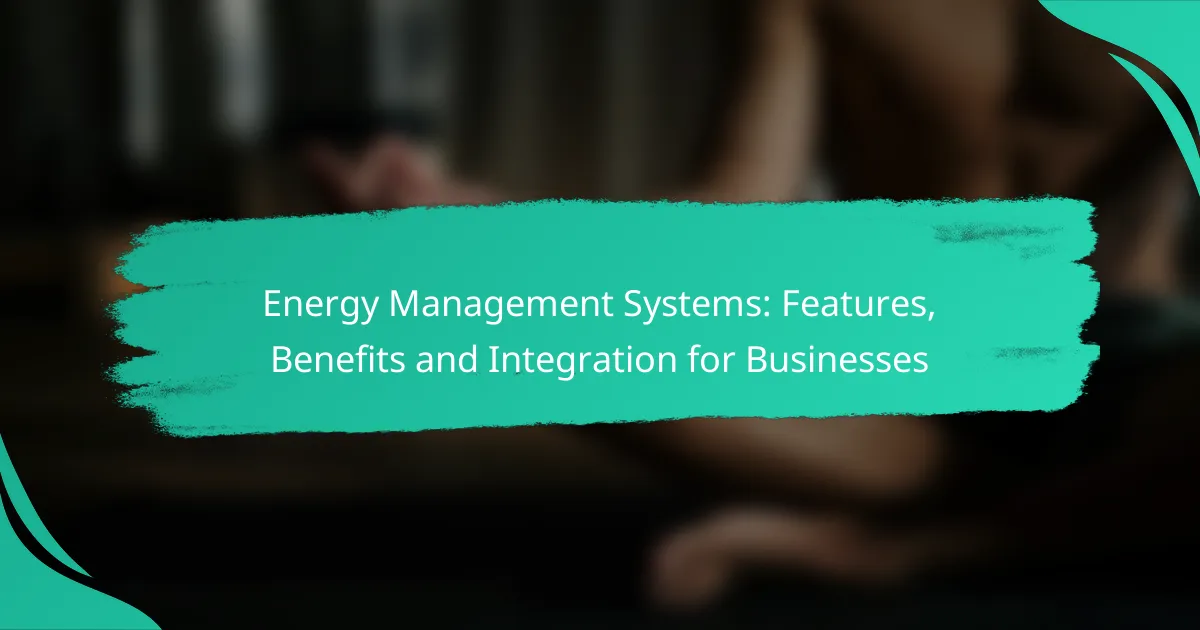Energy Management Systems (EMS) are essential tools for businesses aiming to optimize energy consumption and enhance sustainability. By providing features such as real-time monitoring, data analytics, and integration with IoT devices, EMS enable companies to reduce costs and improve operational efficiency. Implementing an effective EMS allows organizations to make informed decisions and track energy usage, ultimately leading to better resource management.

What Are the Key Features of Energy Management Systems?
Energy Management Systems (EMS) are designed to monitor, control, and optimize energy consumption in businesses. Key features include real-time monitoring, data analytics, automated reporting, integration with IoT devices, and user-friendly dashboards, all of which enhance energy efficiency and reduce costs.
Real-time monitoring
Real-time monitoring allows businesses to track energy usage as it happens, providing immediate insights into consumption patterns. This feature helps identify peak usage times and potential inefficiencies, enabling timely interventions to reduce waste.
For example, a manufacturing facility can monitor energy consumption during different shifts, allowing management to adjust operations based on real-time data. This proactive approach can lead to significant cost savings over time.
Data analytics capabilities
Data analytics capabilities in EMS enable businesses to analyze historical energy usage data and forecast future consumption trends. By leveraging advanced algorithms, companies can identify patterns and anomalies that inform strategic energy management decisions.
For instance, a retail chain can use analytics to determine which stores consume more energy than others, allowing for targeted energy-saving measures. This data-driven approach can enhance operational efficiency and sustainability efforts.
Automated reporting
Automated reporting simplifies the process of generating energy usage reports, saving time and reducing human error. Businesses can schedule reports to be created at regular intervals, ensuring consistent tracking of energy performance metrics.
These reports can be customized to meet specific regulatory requirements or internal benchmarks, making it easier to demonstrate compliance with energy standards. Regular reporting helps organizations stay accountable and informed about their energy consumption.
Integration with IoT devices
Integration with IoT devices enhances the functionality of EMS by connecting various energy-consuming equipment and systems. This connectivity allows for more granular monitoring and control, leading to improved energy efficiency.
For example, smart thermostats and lighting systems can be integrated into the EMS, enabling automated adjustments based on occupancy or time of day. This integration not only optimizes energy usage but also contributes to a more comfortable working environment.
User-friendly dashboards
User-friendly dashboards provide a visual representation of energy data, making it accessible and easy to understand for all stakeholders. These dashboards typically include key performance indicators (KPIs) and can be customized to highlight specific metrics relevant to the business.
By presenting data in a clear and concise manner, dashboards facilitate quick decision-making and help identify areas for improvement. Businesses can use these insights to engage employees in energy-saving initiatives and foster a culture of sustainability.

How Do Energy Management Systems Benefit Businesses?
Energy Management Systems (EMS) provide significant advantages to businesses by optimizing energy use, reducing costs, and enhancing sustainability. By implementing an EMS, companies can track energy consumption in real-time, identify inefficiencies, and make informed decisions that lead to improved operational performance.
Cost savings through efficiency
One of the primary benefits of an EMS is its ability to drive cost savings through improved energy efficiency. By monitoring energy usage patterns, businesses can identify areas where energy is wasted and implement strategies to reduce consumption. For instance, companies may find that upgrading to energy-efficient lighting or optimizing HVAC systems can lead to savings of 10-30% on energy bills.
Additionally, an EMS can help businesses take advantage of time-of-use pricing by shifting energy-intensive operations to off-peak hours, further lowering costs. Regular audits and adjustments based on EMS data ensure that savings are maximized over time.
Enhanced sustainability practices
Implementing an EMS supports enhanced sustainability practices by enabling businesses to track their carbon footprint and energy consumption. This data allows organizations to set measurable sustainability goals and report progress transparently to stakeholders. For example, a company may aim to reduce its greenhouse gas emissions by a specific percentage over a set period.
Moreover, with increasing consumer preference for environmentally responsible companies, businesses that adopt sustainable practices can improve their brand image and attract eco-conscious customers. An EMS can also facilitate compliance with local sustainability regulations, further aligning business operations with environmental goals.
Improved regulatory compliance
Energy Management Systems help businesses stay compliant with energy regulations and standards by providing accurate data on energy usage and emissions. Many regions have specific regulations regarding energy efficiency and emissions reporting, and an EMS can streamline this process by automating data collection and reporting.
By maintaining compliance, businesses can avoid potential fines and penalties while also benefiting from incentives or rebates offered for energy-efficient upgrades. Regularly reviewing compliance requirements and utilizing EMS data can keep companies ahead of regulatory changes.
Better decision-making
With real-time data and analytics, an EMS empowers businesses to make informed decisions regarding energy management. This system provides insights into energy consumption trends, enabling managers to identify inefficiencies and prioritize investments in energy-saving technologies.
Furthermore, by integrating EMS data with other business systems, such as financial or operational software, companies can evaluate the cost-effectiveness of energy initiatives. This holistic view supports strategic planning and resource allocation, ensuring that energy management aligns with overall business objectives.

What Are the Best Energy Management Systems for Businesses?
The best energy management systems (EMS) for businesses are those that effectively monitor, control, and optimize energy usage while providing actionable insights. Key options include Schneider Electric EcoStruxure, Siemens EnergyIP, Honeywell Energy Management Solutions, and IBM Watson IoT, each offering unique features tailored to different business needs.
Schneider Electric EcoStruxure
Schneider Electric EcoStruxure is a comprehensive energy management platform that integrates IoT technology to enhance energy efficiency. It provides real-time data analytics, enabling businesses to monitor energy consumption patterns and identify areas for improvement.
Key features include advanced reporting tools, predictive maintenance capabilities, and a user-friendly interface. Businesses can leverage EcoStruxure to reduce energy costs by up to 30% through better resource management and optimization strategies.
Siemens EnergyIP
Siemens EnergyIP is designed for large-scale energy management, offering a robust framework for data collection and analysis. This system supports various energy sources and provides detailed insights into consumption trends, helping businesses make informed decisions about energy usage.
EnergyIP’s scalability makes it suitable for enterprises of all sizes. It allows for integration with existing infrastructure and can help organizations comply with energy regulations while optimizing operational efficiency.
Honeywell Energy Management Solutions
Honeywell Energy Management Solutions focus on providing tailored energy strategies that align with business objectives. The platform offers tools for monitoring, controlling, and optimizing energy use across facilities.
With features like automated demand response and energy forecasting, Honeywell helps businesses minimize energy costs and enhance sustainability efforts. Companies can expect to see significant savings by implementing these solutions effectively.
IBM Watson IoT
IBM Watson IoT leverages artificial intelligence to provide advanced analytics for energy management. This system enables businesses to connect devices and analyze energy consumption data, leading to smarter decision-making.
Watson IoT can help identify inefficiencies and predict future energy needs, allowing companies to proactively manage their energy resources. Its integration capabilities with other enterprise systems make it a versatile choice for organizations looking to enhance their energy management strategies.

How to Choose the Right Energy Management System?
Choosing the right Energy Management System (EMS) involves understanding your specific energy needs and how well the system integrates with your existing infrastructure. Consider factors such as user support, training, and the system’s ability to adapt to future requirements.
Assess business energy needs
Start by evaluating your current energy consumption patterns and identifying areas for improvement. Consider factors such as peak usage times, types of energy used, and specific operational requirements. This assessment will help you determine the features necessary for your EMS.
For example, if your business operates in a sector with fluctuating energy demands, look for an EMS that offers real-time monitoring and analytics. This can help you optimize usage and reduce costs effectively.
Evaluate integration capabilities
Integration capabilities are crucial for ensuring that your EMS works seamlessly with existing systems, such as building management or production software. Check if the EMS can connect with your current infrastructure, including IoT devices and data management platforms.
Consider systems that support open standards and APIs, as these will provide greater flexibility and scalability. A well-integrated EMS can enhance data flow and improve overall energy efficiency.
Consider user support and training
User support and training are essential for maximizing the benefits of your EMS. Look for providers that offer comprehensive training programs and responsive customer support. This will ensure that your team can effectively use the system and troubleshoot any issues that arise.
Additionally, consider the availability of online resources, such as tutorials and user forums, which can provide ongoing assistance. A strong support network can significantly enhance your EMS experience and lead to better energy management outcomes.

What Are the Integration Options for Energy Management Systems?
Energy Management Systems (EMS) can integrate with various existing technologies and infrastructure to enhance efficiency and data management. These integration options allow businesses to leverage their current assets while optimizing energy consumption and operational performance.
Integration with existing infrastructure
Integrating an EMS with existing infrastructure involves connecting it to current energy sources, control systems, and data management platforms. This can include linking to smart meters, HVAC systems, and renewable energy sources like solar panels. The goal is to create a cohesive system that provides real-time data and insights into energy usage.
When considering integration, businesses should assess the compatibility of their current systems with the EMS. This may involve evaluating communication protocols, data formats, and hardware interfaces. For example, using open standards like BACnet or Modbus can facilitate smoother integration with building management systems.
It’s crucial to plan for potential challenges during integration, such as data silos or legacy systems that may not support modern EMS features. Conducting a thorough audit of existing infrastructure and identifying areas for improvement can help streamline the process and maximize the benefits of the EMS.
